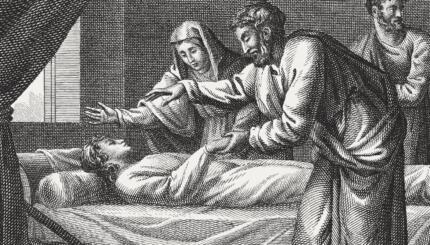This commentary is provided by special arrangement with American Jewish World Service. To learn more, visit www.ajws.org.
After the soul-searching introspection and close setting of our Rosh Hashanah and Yom Kippur experiences in synagogue, the holiday of Sukkot provides the sharpest of contrasts. Rather than continue to focus on our innermost thoughts and deeds, we are commanded to get outside—outside of our selves, and outside of our homes, eating our meals under the stars.
This reminder for Jews to keep balance in their lives, to be in touch with nature as well as the prayer book, strikes me each year on my visit to the hardware store in preparation for the holiday. I smile on seeing bookish young Torah scholars inquiring about hammers, pliers and extension cords, part of the annual imperative—and opportunity—to forego the study hall for a week for the mitzvah of eating (and for some, sleeping) in the sukkah.
God commands us: “You shall live in booths seven days; all citizens in Israel shall live in booths, in order that future generations may know that I made the Israelite people live in booths when I brought them out of the land of Egypt; I am the Lord.” (Leviticus 23:42–43) In this way we recall the wanderings of our ancestors in the desert for 40 years, between their exodus from Egypt and their entering the Promised Land of milk and honey. They had no permanent shelter during those four decades, but were protected by God’s presence in the form of a cloud by day and fire at night, with manna falling from the heavens each weekday to provide nourishment.
The ancient holiday of Sukkot is perfectly in sync with current cultural values, from its emphasis on agriculture, celebrating the harvest—symbolized by the unity of the four species in the lulav and etrog we hold during prayer—to the practical message of our reliance on and appreciation of nature as we sit in our sukkot, vulnerable to the elements.
The key component of the sukkah is the s’chach, or roof, which must be made from organic material, such as bamboo or cornhusks; no nails or metal are permitted. And the roof must be thick enough to provide mostly shade but be open enough to let some sunlight in during the day and to see the stars at night.
Just as the Passover seder provides an experiential drama of the exodus from Egypt—we taste the bitter herbs to remind us of the slavery our ancestors endured and drink four cups of wine to mark their liberation—the time spent in our sukkah on this festival relives the dependency on God the Israelites felt during their 40 years adrift in the desert.
In an age of rampant materialism, when our homes have the most up-to-date technological advances and we can control heat, light and all our needs with the push of a button or click on a computer, the holiday of Sukkot reminds us to stop and appreciate from whence our protection truly comes.
As Jews throughout the ages have learned, tragically, during centuries of wandering in the diaspora, no matter how grand their homes were, they were only as secure as the whim of surrounding governments and societies. Too often the winds of hatred prompted our grandparents and great-grandparents, and those who came before them, to flee for their lives—if they were fortunate enough to escape bloodshed fueled by anti-Semitism.
Today we have the good fortune to live in a country with more religious freedom than any diaspora community in history. But Sukkot reminds us to look beyond our four walls and consider those around the world coping with levels of insecurity we can barely fathom. How many millions live in poverty, are displaced by floods and earthquakes, or face daily repression from corrupt governments?
The blessings in our own lives inspire us to reach out beyond our own needs to attend to those of others, to recognize that our planet’s resources are a gift but not a guarantee, and that we must do all we can, in partnership with our Creator, to preserve, protect and enhance this world we share.
On Sukkot we step out of our comfort zone and into the sukkah, reconnecting with ancient traditions and establishing new commitments to sanctify this world and all who inhabit it.
In the coming days, as we sit outside in the cool autumn air, may the warmth of the sun and the nighttime glow of the stars inspire us to reach both heavenward and deep within our hearts to do God’s work on earth.
Chag sameach.
etrog
Pronounced: ETT-rahg, Origin: Hebrew, a citron, or large yellow citrus fruit that is one of four species (the others are willow, myrtle and palm) shaken together as a ritual during the holiday of Sukkot.
lulav
Pronounced: LOO-lahv (oo as in boo), Origin: Hebrew, a bundle of branches representing three species -- willow, myrtle and palm -- which are shaken together with the etrog on Sukkot.
mitzvah
Pronounced: MITZ-vuh or meetz-VAH, Origin: Hebrew, commandment, also used to mean good deed.
Rosh Hashanah
Pronounced: roshe hah-SHAH-nah, also roshe ha-shah-NAH, Origin: Hebrew, the Jewish new year.
seder
Pronounced: SAY-der, Origin: Hebrew, literally "order"; usually used to describe the ceremonial meal and telling of the Passover story on the first two nights of Passover. (In Israel, Jews have a seder only on the first night of Passover.)
sukkah
Pronounced: SOO-kah (oo as in book) or sue-KAH, Origin: Hebrew, the temporary hut built during the Harvest holiday of Sukkot.
Sukkot
Pronounced: sue-KOTE, or SOOH-kuss (oo as in book), Origin: Hebrew, a harvest festival in which Jews eat inside temporary huts, falls in the Jewish month of Tishrei, which usually coincides with September or October.
Torah
Pronunced: TORE-uh, Origin: Hebrew, the Five Books of Moses.
Yom Kippur
Pronounced: yohm KIPP-er, also yohm kee-PORE, Origin: Hebrew, The Day of Atonement, the holiest day on the Jewish calendar and, with Rosh Hashanah, one of the High Holidays.


